What do Wassily Kandinsky, John Cleese, Paul Robeson, and Andrea Bocelli have in common? Besides being creative geniuses, all have law degrees.
We found plenty of Wisconsin lawyer-artists – painters, actors, writers, filmmakers, musicians, or involved in some other creative endeavor. A few of these lawyers are briefly profiled here.
What drives lawyers to combine their pursuit of art and the law? For some of them, art was once a career, while for other lawyers, artistic pursuits have always been an avocation. Some former artists now use their legal skills to assist other creative individuals. And others, whether artists or nonartists, strive to enhance the arts scene in their communities.
Brent Skinner: Avoiding Ruts and Grooves
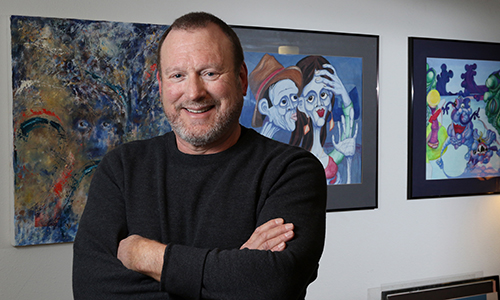
Menomonie attorney Brent Skinner in his studio. Photo: Dan Reiland
For Brent Skinner, painting is an antidote to the self-absorption that can plague people in the legal profession. “We get wrapped up in being right and get caught up in our world, our perceptions,” he says. “Anything that shakes that up is good.”
Skinner, a sole practitioner and court commissioner in Menomonie, Wis., turned to painting as an avocation some 15 years ago, after his two children were grown and he had more free time. He’s had no significant formal art training – only a local landscape-painting class he took several years ago. “I think I flunked it,” he says with a laugh. “I was terrible.”
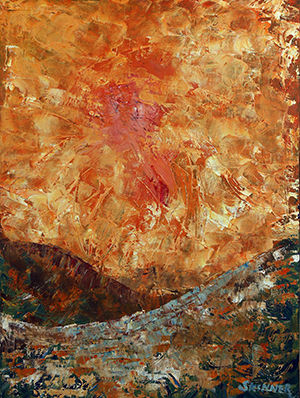
“Sunrise,” oil on canvas, 18” x 24,” © 2010. Brent Skinner explains
that “Sunrise” is intended to express optimism, a rather stark landscape
that becomes something more. Photo: Dan Reiland
Landscapes just aren’t Skinner’s thing. He prefers to create art works that are fanciful and playful. “For me, painting is a time of meditation, a time of play,” he says.
Still, his analytical side enters into his art, too. It’s not solely an intuitive process, he says. “You have to think: If this object were here, how would the shadow fall? How would it relate to other things in the painting?” he explains. “So it is analytical, but in a different way from how lawyers typically analyze things.”
When he works in watercolors, his technique has to be fairly precise and careful, as he layers paint over paint to achieve the right color and effect. “With oils, I’m just slapping paint around,” he says. “I get it on myself, on the walls.”
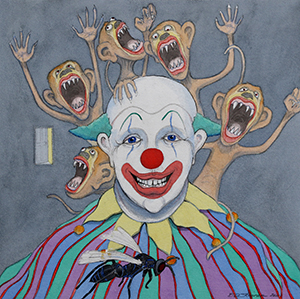
“Coping” (self-portrait), watercolor on paper, 18” x
18,” © 2011. This painting reflects what most people
experience, whether or not we recognize or acknowledge
it, says Brent Skinner. The monkeys are our anxieties
and delusions, and we tend to deny their existence in a
clownish manner. By doing so we risk a sting from the
wasp of reality. We can move beyond the pain by finding
a doorway to new perceptions.
Painting allows Skinner to come back to his legal work with “fresh eyes,” he says. “The result may be the same, but at least I’ve looked at the matter from a broader perspective.”
What’s more, his artwork stretches his imagination. “I think professionally lawyers prefer ruts and grooves,” he says. “We fall into the danger of becoming stagnant. So anything that can stimulate the imagination is important. This does it for me.”
Loretta Webster: Connecting to Her Heritage
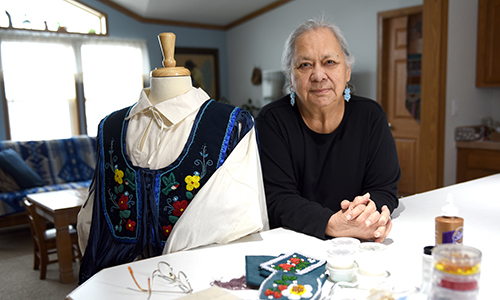
Loretta Webster, nationally recognized for her
raised beadwork, stitches a strawberry design for a
medicine box. All six pieces are beaded separately, and
then sewn together.
Loretta Webster, a retired lawyer with the Oneida Tribe Division of Land Management, has been creating beadwork since she was a teenager. But a couple of decades ago, when she was in her 50s, her work took a new direction with her discovery of raised beadwork, as opposed to flat beadwork.
“I was fascinated by the three-dimensional effect of raised beads,” Webster says. “I couldn’t get over how beautiful the larger beads made the object you were creating and all the different stitches you could learn. There are no strict rules in doing raised beadwork, so there’s a lot of room for creativity.”
The roots of raised beadwork go back to the Iroquois nations in New York, starting in the 1850s. By that time, the Oneida, also part of the Iroquois Confederacy, already had migrated to Wisconsin after the Iroquois tribes lost most of their land in New York.
Thus, the Wisconsin Oneida didn’t bring the raised beadwork technique with them. “We missed that tradition,” Webster says. She first learned raised beadwork from two members of the Cayuga Nation in New York, also part of the Iroquois Confederacy, who conducted classes at the Oneida Nation Museum in Oneida, Wis.

In this photo, Ernie Stevens Jr., executive director of
the National Indian Gaming Assoc., Green Bay, and his wife
are wearing beadwork made by Loretta Webster. Ernie’s full
Iroquois ceremonial outfit includes a Gustowe (headpiece),
cuffs, belt, shirt, leggings, apron, and side-drops. He is
carrying an eagle shoulder bag. His wife is wearing a beaded
yoke and cuffs to match.
Clan symbols of bear, wolf, and turtle appear on different
pieces of Ernie’s outfit, as well as the eagle on the bandolier
bag. White beaded edging is prominent on just about every
item of the outfit, which is beaded on black velvet, except
for the apron, which is black wool. The red shirt has the
six diamonds of the Oneida wampum belt appliqued on the
front. This signifies the expansion of the Iroquois Confederacy
to include a sixth tribe, the Tuscaroras. Ernie’s outfit
took about a year-and-a-half to make. Photos: Dennis King
This art form has surged here and elsewhere, and Webster has been a major part of making that happen, through her own creations and by teaching classes. She’s participated in numerous art shows, won prizes, and will be part of an exhibit of raised beadwork at the James Watrous Gallery of the Wisconsin Academy of Sciences, Arts & Letters in Madison this September.
Through raised beadwork, “we get the feeling of connecting to our history, heritage, and culture,” Webster says, “and to the people back in New York. This is something that pulls us all together.”
She also sells her work through her Bear Paw Keepsakes website,
www.bearpawartgallery.com. “But you do it because you love it,” Webster says. “It soothes your soul when you’re doing any kind of art work.”
Faith Kohler: Documenting Societal Problems
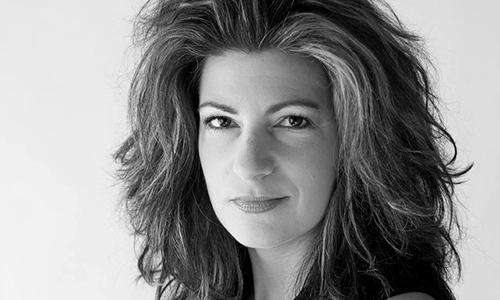
Faith Kohler puts homelessness on the silver screen
in “30 Seconds Away: Breaking the Cycle.” View the
trailer and learn more about the subjects, the crew, next
screenings, and more at www.30secondsaway.com.
When Faith Kohler began volunteering at a Milwaukee homeless persons shelter some years ago, she knew she wanted to make the best use of her skills. “I can tell you that nobody would want to eat a lunch I cooked,” she says. “I was trying to find some other way to be productive.”
A staff member told her the most useful gifts she could offer were time and personal connection. Homeless people “don’t get talked to; they get talked at while they’re waiting in line for something,” Kohler points out. “They don’t have conversations with people in the community, and they’re isolated.”
Her conversations with a man named Harold Sloan eventually turned into a creative project. She started recording their talks on her phone, and soon others in the homeless community wanted to tell their stories, as well.
Kohler recognized possibilities for a documentary. A neighbor who’s a film professor steered her to students looking for a film project. After six years of work, “30 Seconds Away: Breaking the Cycle” premiered at the Milwaukee Film Festival in September 2015.
When Kohler began this project, she was working as a law enforcement agent for the U.S. Postal Inspection Service, which she did for 13 years. Before that she was a lawyer in private practice for five years. Today, she’s the corporate security manager at Johnson Controls in Milwaukee.
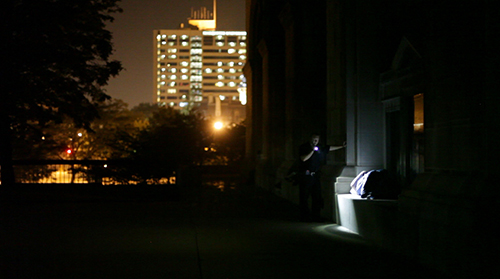
A police officer checks the welfare of a homeless
man sleeping outside the Milwaukee Municipal Building.
Faith Kohler developed the idea for the film “30
Seconds Away: Breaking the Cycle” in 2009, when she
was volunteering at a local homeless persons shelter.
One of the men who frequented the shelter began telling
her about how he became homeless years ago and why
he was still chronically homeless. Other people at the
shelter wanted to share their stories as well.
Kohler noticed a few common threads in the wide
variety of stories she heard. One was a sense of total isolation
from the rest of society, another was an extreme
dislike of law enforcement, and the biggest was a pattern
of repeated trips in and out of the justice system that
ended with people back outside on the street.
Film enabled Kohler to share stories in their original
voices … homeless men, law enforcement, a judge, prosecutors,
a defense attorney ... all sharing their unique
perspective on issues of mental health, substance abuse,
law enforcement strategies, available resources, and
other factors found in chronic homelessness. “To me,
film was a way of humanizing what we as attorneys
might otherwise define as ‘issues.’” The end goal was
to raise awareness throughout communities, and inspire
service to a community that might otherwise remain
isolated. Photos: “30 Seconds Away” production crew.
She also co-owns a business that designs and sells concealed-carry handbags. “I’m a girly girl,” Kohler explains, adding she could never find a bag she liked for carrying a gun on her law enforcement job. She hooked up with designer Jodi Been to launch Been & Badge in 2014, which makes stylish handbags for women, whether or not they carry a handgun.
Plus, Kohler has established a nonprofit to make future documentaries about social justice issues. Working on the film about homelessness “allowed me to analyze and try to get to the root of an ongoing societal problem,” Kohler says, “while at the same time building relationships with people most members of our community never meet. That’s where my joy is. I need to feel I’m contributing something good.”
Susan Parsons: Left Brain, Right Brain

Bestselling author Susan Parsons – writing under the
pen name Susan Gloss – says when she’s not writing
fiction or toddler wrangling, she can be found working as
a lawyer, heading an online vintage shop at Cleverly Curated,
or seeking inspiration for her blog, GlossingOverIt. Photo: Nick Wikes
Creative writing and legal writing are perfect complements for Susan Parsons, now a staff attorney for the Wisconsin District IV Court of Appeals, Madison. Before her current job she was in private practice and clerked for the late Wisconsin Supreme Court Justice Patrick Crooks.
“I’ve done creative writing since I was a child,” Parsons says. “It’s a nice contrast to my legal writing, which I enjoy as well. But legal writing is very analytical. With creative writing I get to use a different part of my brain.”
Her efforts resulted in her first novel, Vintage, which was published by William Morrow/Harper Collins in 2014 under Parson’s pen name, Susan Gloss, also her maiden name. The book’s setting is a vintage clothing shop – a natural choice for Parsons, given her fondness for meandering through vintage stores and garage sales.
“I enjoy looking at other people’s old things and imagining the stories behind them,” she says. “Vintage clothes capture my imagination in that way. Running with that idea was what led to this novel,” which is a USA Today Bestselling Book and a Midwest Independent Booksellers Association “Midwest Connections” pick.
Tell Us!
What is your creative outlet? Whether
you create art, or represent others who do, tell
us how you express your creative side. Send
us your photos, too. Post a comment at the end of this article or
email the editors at wislawmag@wisbar.org.
Her law background and legal writing experience come in handy in writing a novel, Parsons says. For instance, in Vintage, the shop owner is having problems with her landlord.
“Elements of law enter into people’s everyday lives,” she explains, “especially for people having problems. In fiction, you always have people who have problems. That’s the conflict that makes the book interesting. Having a legal background and vocabulary helps me to explain and figure out some of life’s problems in fiction.”
Parsons, or Gloss, is currently working on her second novel for the same publisher as her first. “People sometimes ask me if I wish I could write full time and not practice law anymore,” she says. “My answer is no. I enjoy both careers. I’m always writing. I just have two different ways of using that skill.”
Michael Reyes: Bringing People Together Through Music
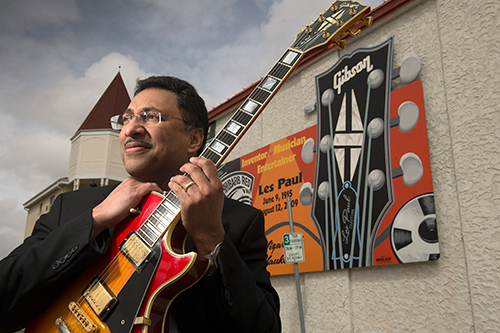
It seems fitting that Michael Reyes should riff on his Les Paul guitar in front of the Les Paul Museum mural in Waukesha.
He particularly enjoys organizing and participating in music educational activities for children and adults featuring some
of the national and international artists his music groups have invited to perform in Wisconsin and the Midwest.
Photo: Kevin Harnack
Waukesha attorney Michael Reyes has built a reputation as a Milwaukee area “Music Man.” “I get lots of enjoyment,” he says, “in seeing diverse audiences come together and celebrate and learn about each other. The best way I’ve found to do that is through the arts, particularly music.”
Reyes grew up surrounded by music in Cleveland, Ohio, the home of the Rock and Roll Hall of Fame and Museum. The area also had thriving rhythm and blues groups, the Motown influence, a world-class symphony orchestra, and diverse ethnic groups, each with its own music. Latino music was part of Reyes’ upbringing due to his Puerto Rican heritage.
He started taking guitar lessons in grade school, studied classical guitar in college, and played in a few bands while at the U.W. Law School. Since beginning to practice law in 1987, Reyes’s music involvement has mostly shifted from playing and performing to promoting and supporting music programs. Still, he’s recently begun to play again and perform at church and community events with his 16-year-old son.
Over the years, he’s succeeded in bringing many music artists to Milwaukee – for instance, the chamber music jazz artist series at the Pabst Theater. He and a couple of other lawyers started a promotional group that “resulted in becoming the go-to guys,” he says, “for Latin music, world music, and jazz for various presenters in town.”
Currently he’s president of the board of the Latino Arts program at the United Community Center in Milwaukee. Latino Arts brings in artists from all over Latin America to present concerts, workshops, and master classes.
Reyes also serves on the board of the Wisconsin Conservatory of Music, where Liberace took his first piano lessons, and previously served on the Wisconsin Arts Board. A small part of his law practice involves entertainment law, mostly negotiating contracts and licensing agreements for musicians.
As Reyes sees it, his involvement in music “is all about the enrichment and enhancement of the cultural life of the city. It’s a passion I have to feed.”
Beth Eisendrath: Striking a Balance
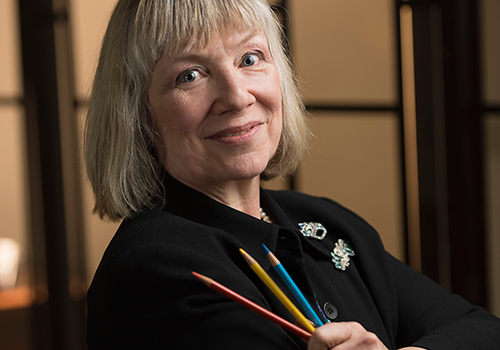
Beth Eisendrath has a long history in the arts – as a
student, painter, art gallery co-director, teacher, and
now designer of greeting cards. She keeps art
supplies in her law office, and says “working concentratedly
on a drawing, painting, or design project
allows legal problems to simmer and incubate.
Answers can come as I examine a different solution
in an unrelated discipline.” Photos: Kevin Harnack
Beth Eisendrath’s art career preceded the 14 years she’s been practicing law. She earned her bachelor of fine arts in painting and drawing, after which she painted, sold her work, and won awards. To help pay the rent, she did drywalling, modeling, and other odd jobs before going back to school for an art education degree and then teaching art in elementary school for two years.
Her next stop was what she calls her “dream job” at that time. A family who owned an art gallery on Milwaukee’s east side asked her to join their daughter to co-direct the gallery. “I got to help shape the gallery’s identity,” Eisendrath recalls, “and to see hundreds of slides of artists’ works every week. We did shows, and I designed the invitations.”
When the co-director moved to Chicago five years later, the gallery closed, and Eisendrath weighed her options. She’d long had an interest in law – her father was a Milwaukee lawyer – so she decided to enroll at Marquette University Law School. She got her J.D. in 2002 and now has a solo practice in Wauwatosa.
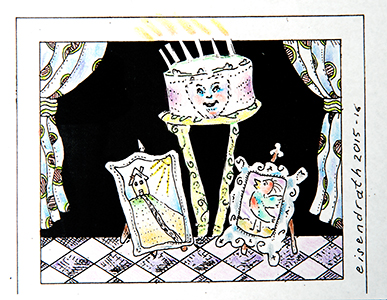
A greeting card designed by Beth Eisendrath.
Eisendrath put aside art-related endeavors for several years while in law school and getting settled into practice. But for the past few years, she’s again taken up designing greeting cards. She expects to return to creating full-scale paintings someday, too.
“I love having several cards in the hopper,” she says, noting that she carves out time during weekday evenings and weekends. Nearly every weekend, she goes to her law office to do administrative work. “I have art supplies there,” she says. “I’ll make art to take a break and stretch my brain. I go into some sort of flow state, a relaxed state. That helps me solve problems.”
In that way, art is an asset to her work as a lawyer, Eisendrath says, and to life in general. “I think I’m a happier, more centered person,” she says, “now that I have my art back in my life.”
Joe Cardamone: From Page to Stage
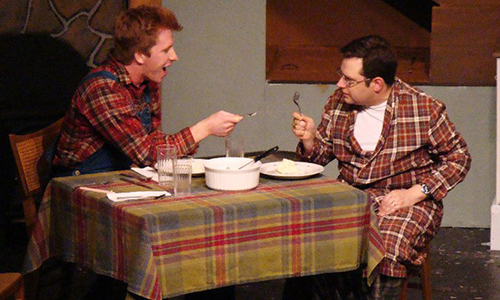
Joe Cardamone is a man of many talents – from playing
piano to acting in and directing theatrical performances
to singing with the U.W.-Parkside Master Singers. In 2011,
Joe performed in “Foreigner” (above, he’s on the right).
Joe Cardamone’s involvement in community theater goes back about 15 years. When he got cast for a part in his first play, his fellow actors were surprised to learn he was a lawyer.
“I don’t know why,” he says, “because lawyers are performers – at least those of us who are litigators and are in court on a daily basis.”
Cardamone’s legal career has included stints as a litigator, both in a district attorney’s office and in private practice. Now he’s the corporation counsel for Kenosha County, and he sees a different kind of parallel between his roles in law and theater.
As corporation counsel, he says he has “one client with about four dozen different parts.” He sees himself as a transactional attorney, whose job is to devise creative solutions. “I think that’s akin to the way I approach directing,” he says. “You have a script, finite resources, a space, and somehow you have to make what’s on the page come alive in front of an audience. To a certain extent, directing is creative problem solving.”
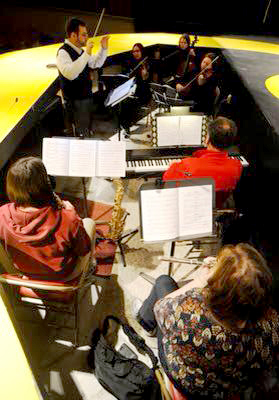
Joe Cardamone recently wrapped up directing “Wizard of Oz” for which he
also conducted the pit band.
Cardamone’s leaning toward artistic interests started in his childhood. At age six, he told his parents he wanted to learn to play the piano. He continued taking lessons through high school, and at Carleton College he acted, performed in musicals, directed, and worked part time as a piano accompanist for the music department.
His community theater work now mostly entails directing musicals. He’s taking a break this season after the birth of his second child in August. But he’ll soon get back to directing, and he figures someday he’ll resume acting, too.
“I think back to the first musical I directed in college,” Cardamone says. “There’s no way to describe the satisfaction I got when something I had pictured in my head while I was reading a script was coming to life in front of me. And people in the audience were reacting the way I’d hoped they would. That thrill has not subsided for me.”
Peter Strand: Identifying with Creatives
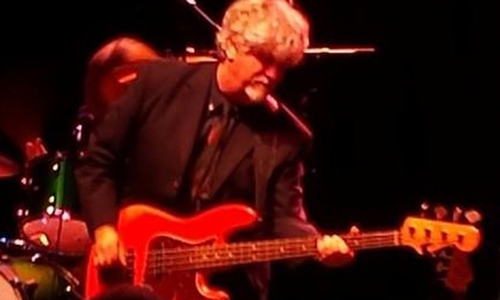
Before becoming an attorney, Peter Strand played and
recorded as a full-time touring musician with several
bands including recording two albums for RCA/Millennium
Records. He continues to play
sporadic gigs with a Chicago band.
Before becoming a lawyer in 1987, Peter Strand was a professional musician for eight years. He toured with various bands and recorded two albums for RCA/Millennium Records. “Music was my gateway to entertainment law,” Strand says.
After graduating from the U.W. Law School, Strand got a job as a litigator with a big Chicago firm. But occasionally old acquaintances in the music world would ask him to review a contract or provide other legal advice. Some became regular clients. “From there,” he says, “it was an evolution.”
By 2009, Strand and Tom Leavens were ready to form their own Chicago firm, now called Leavens, Strand & Glover LLC, with a focus on entertainment, media, and intellectual property law. It’s a perfect fit for Strand.
“When I work with creatives,” he says, “I think I have a better connection because I’ve been in the position of creating, recording, and performing. I understand their business and concerns. And I think clients can tell I’m a fan of music.”
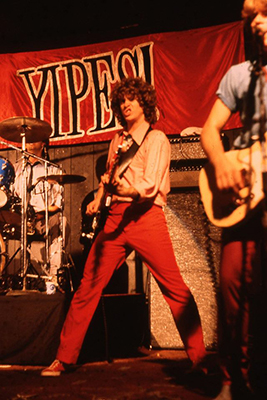
Peter Strand played with the Milwaukee-based Yipes! during the late 1970s and early 1980s, opening for
Cheap Trick among other notables.
He still keeps his guitar at hand, and he performs sporadically with a Chicago band. His old Milwaukee band, Yipes!, got inducted into the Wisconsin Music Hall of Fame in 2013 and played a reunion show at the 2014 Summerfest.
Strand is heavily involved in Lawyers for the Creative Arts in Chicago, a group that does pro bono legal work for artists. He also helped create the Volunteer Lawyers for the Arts Division of the ABA Forum on the Entertainment and Sports Industries. And he was named the Chicago Entertainment Law – Music “Lawyer of the Year” for 2016. Somehow he finds time to teach a course in entertainment law at Chicago-Kent College of Law.
In one of his recent matters, he handled the legal work for a gospel choir comprised of Sears employees who made a recording. “I went out to the Sears campus,” he says, “and spent time listening to the choir, getting signed releases, and so on. When I have a day like that I think, this is why I like to do this.”
Elizabeth Russell: Shaping an Arts Law Practice
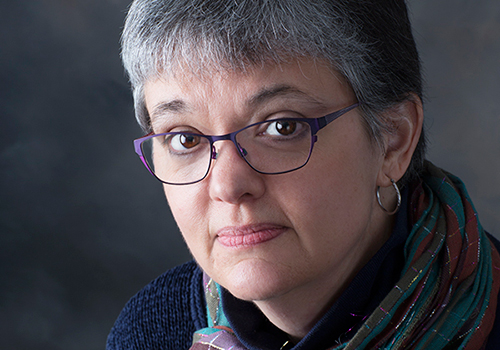
Elizabeth Russell is fond of asking, “how many lawyers
do you know who went to law school on a bassoon
scholarship?” Russell helps businesses protect their
copyright, trademark, and digital business assets, and
maintains a vibrant arts law practice.
Elizabeth Russell has blended a bassoon major, a law degree, and years of arts administration experience into a career as an arts lawyer. In that role, “I serve clients who make art,” she says. “They have a wide variety of legal needs.” (See her article “Contracts for Creative Works” in this issue.)
It was after college and realizing that she didn’t really want to be a high school band teacher that Russell went to law school. She practiced in various settings for several years and then veered into arts administration. She worked for the Albany (N.Y.) Symphony Orchestra, and then after moving to Madison, went to work for the former Madison Repertory Theater and Opera for the Young. In 2000, she opened a solo arts law practice.
“When I was in the arts administration environment,” Russell says, “I saw the unique legal needs of performers, primarily. Those needs were unmet. Individual artists are not good matches for big law firms.”
Russell saw her niche and molded it into what she’d envisioned back in law school. She would be a lawyer who represented people who were doing things that interested her – namely artistic endeavors. “I created the exact practice that I enjoy,” she says.
Initially, her clients were mostly artists of diverse types. But her client list has expanded to other businesses, assisting them with copyright, trademark, and digital business matters. “When businesses started doing business online,” she says, “copyright and trademark became extremely relevant for most any business anywhere.” She works with clients in the U.S., as well as other countries.
She’s also author of an award-winning book, Arts Law Conversations: A Surprisingly Readable Guide for Arts Entrepreneurs, and she’s a frequent speaker on arts law topics. As an author and speaker, she enjoys taking complicated issues and explaining them in understandable terms, describing herself as “remarkably fluent in plain English.”
Russell sees excellent opportunities for anyone who feels drawn to arts law. Her advice is to “sit down and visualize what you want your practice to be,” she says. “That’s being creative and artistic in itself.”
Raymond Krueger: Fueling Community Appreciation for the Visual Arts

Raymond Krueger believes showcasing the “creative genius of people” is especially important for engaging young
people, who have a strong, lively social and cultural base, and for promoting community vitality and economic growth.
He served on the Milwaukee Art Museum’s Building Committee and was instrumental in restructuring the museum’s real
estate relationships with the City of Milwaukee and Milwaukee County. The museum’s recent renovation and build-on
required a complete re-installation of the permanent collection, and resulted in 1,000 more works on the walls than
before. Photo: Images ©2016 John Nienhuis
Raymond Krueger’s fascination with the visual arts dates back to a young age. He’s never painted, sculpted, or otherwise created visual art works, although he says his now-grown children have dabbled a bit.
Still, Krueger, an attorney with Michael Best & Friedrich in Milwaukee, has found many ways, spanning over decades, to devote himself to the visual arts. While he’s not creating art works, he’s helping to build a vibrant arts scene in Milwaukee – and beyond.
For instance, for 20 years, he chaired the Georgia O’Keeffe Foundation in Abiquiú, N.M., which was dedicated to perpetuating O’Keeffe’s legacy. Closer to home, he served on the board of trustees for the Milwaukee Art Museum for 12 years, including three years as president and three years as chair. He also served on the building committee for the museum’s Santiago Calatrava addition, which has become an internationally recognized symbol of the city.
Krueger takes pride in the art museum’s outreach efforts. For example, the museum’s “After Dark” events for 20- and 30-somethings “have a cool factor,” he says. These are social events, which at the same time attract young adults into the galleries to experience art.
The museum also brings in some 60,000 school-age children each year for museum tours. “I’ve taken the tour with my grandson,” Krueger says, “and sat on the floor with the kids to see how they react. They’re spellbound. The experience opens their eyes.”
Dianne Molvig is a frequent contributor to area and national publications.
The desire to fuel that kind of appreciation for the visual arts is what drives Krueger in his community arts involvement, as well as in representing clients in the architecture field.
“Inevitably when you’re involved in these projects,” he says, “you find your legal training comes into play. You’re able to assist in that way and add value to whatever the project or organization is trying to do.”
He advises all lawyers, especially young lawyers, to keep their eyes open for these sorts of opportunities. He’s established an annual tradition of taking his firm’s summer associates to the Milwaukee Art Museum for a tour. “I always tell them to find balance in their lives,” he says. “Find something you love to do and make time in your professional life to do it.”
